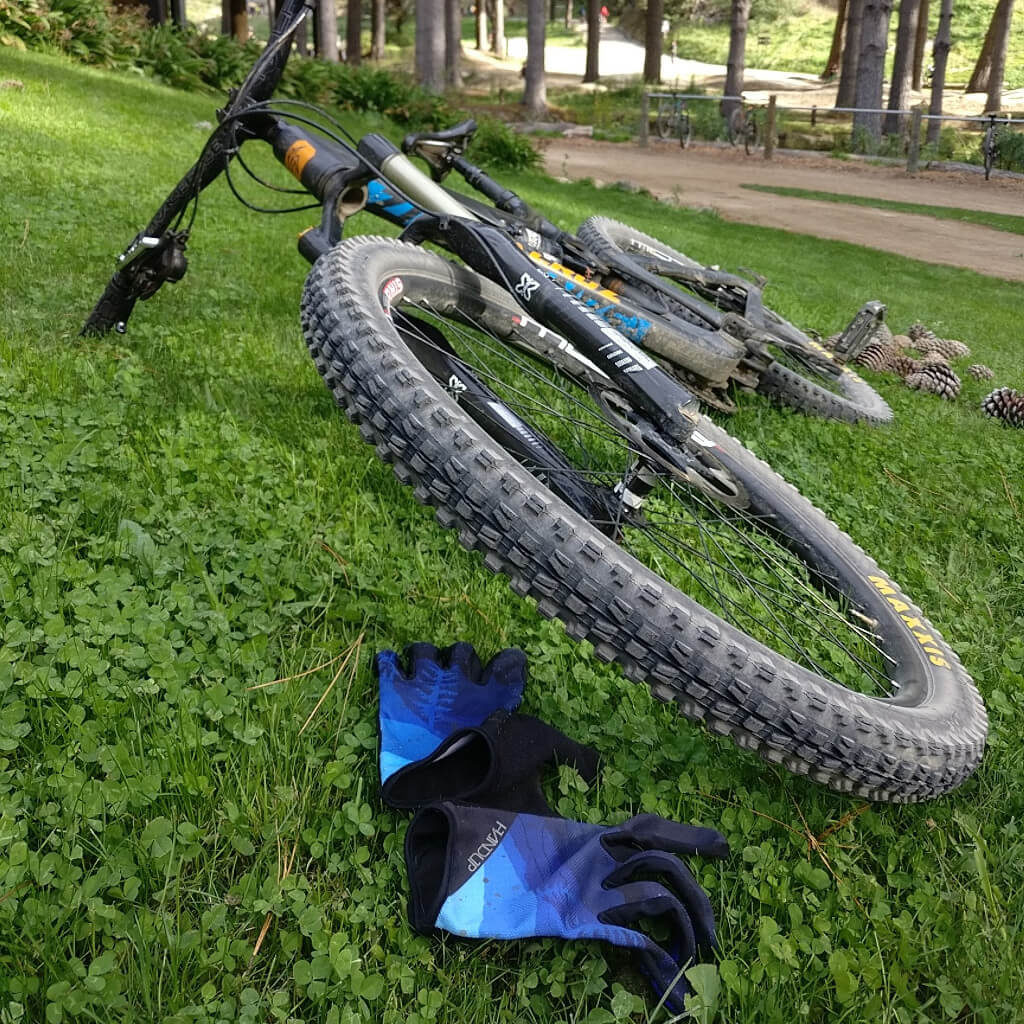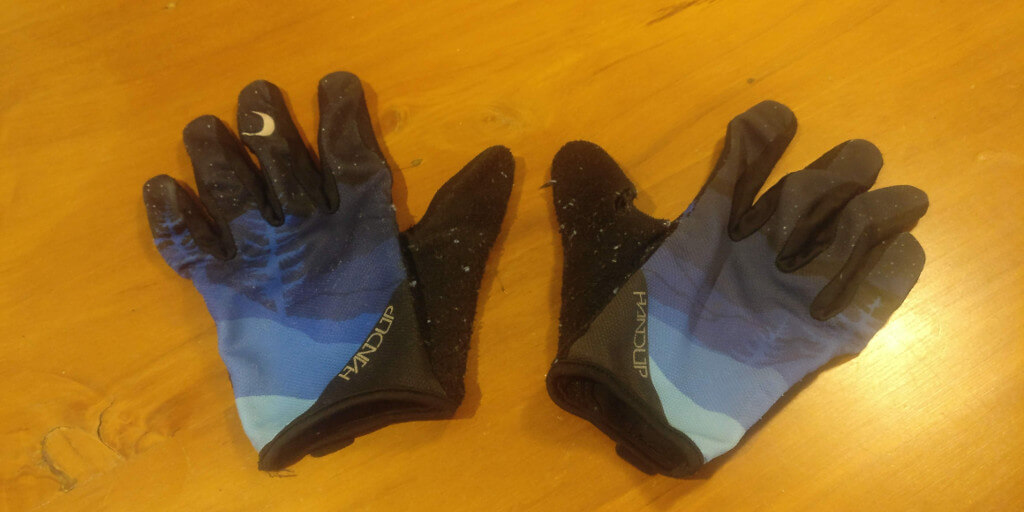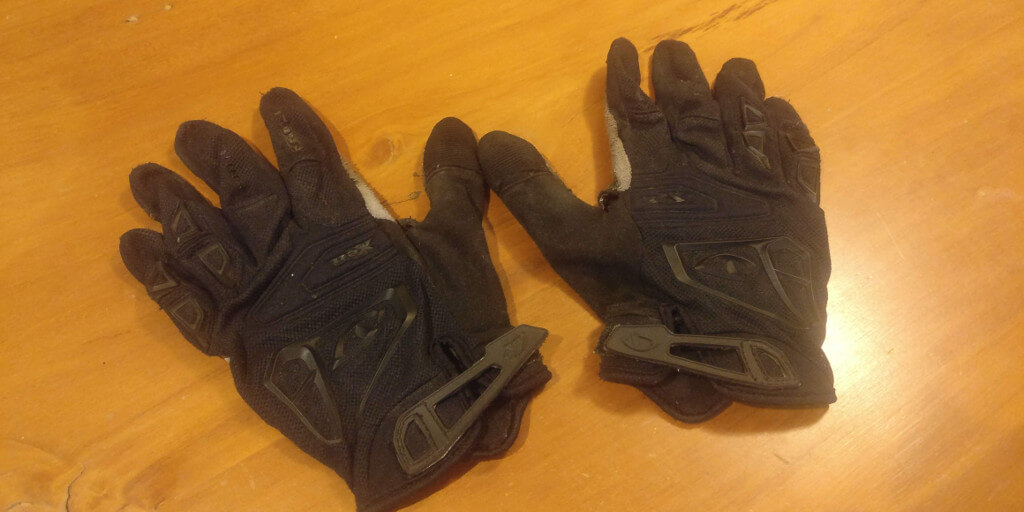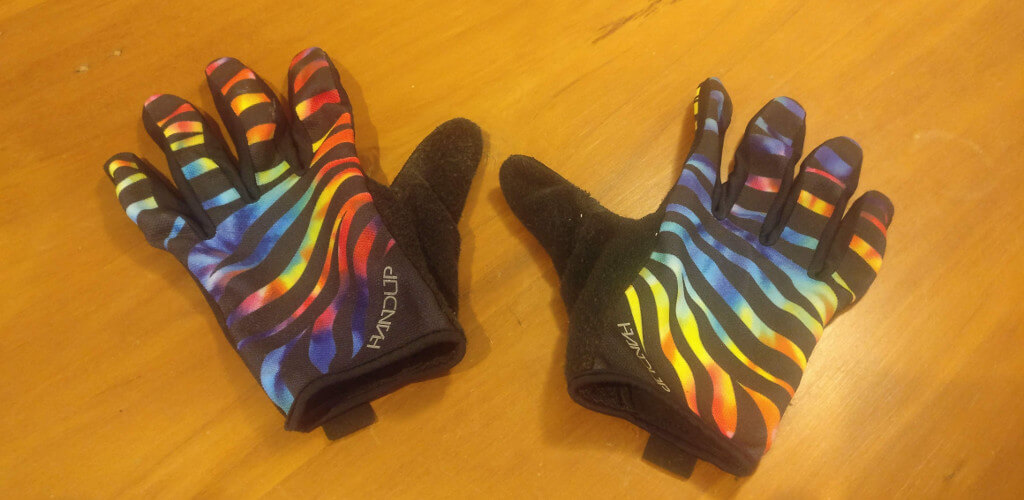The two main reasons mountain bikers wear gloves, are to help protect the hands in the event of a crash, and to maintain a good connection to the handlebar grips regardless of weather conditions, or other moisture such as sweat.
When we’re out on the trail we have a few key contact points with the bike.
The grips which we’re holding onto are usually going to be made of some sort of rubber, with a grippy pattern – some much more effective than others.
But beyond the grips themselves, there are always going to be other factors in mountain biking which determine how much actual grip we have.
And sometimes of course, crashes are going to happen regardless – and pretty often we’re going to throw our hands out in front of us when we hit the dirt, so gloves can come in handy here too, helping prevent too much damage to our fingers and palms as we hit the ground.
So today we’re going to dig into why we would want to wear gloves while out riding.

Why wear gloves?
The majority of mountain bikers find gloves useful to give them a predictable level of grip on the bars, however sweaty they might be getting, or how much rain is falling for instance.
Some types of grips in particular actually get quite slippery once sweat or rain is introduced into the equation.
The type of gloves and grips preferred by each rider is going to vary widely.
I prefer thicker grips for my large hands, and find they help deaden a bit of the vibration you get from a days riding in the bike park for example – especially if the braking bumps are getting pretty brutal at high speed!
For gloves I like to wear quite minimal ones, with no padding, so I have a very direct feel of the grips.
Crashing is inevitable when mountain biking for any length of time – but often the potential for cuts and grazes from these crashes can be mitigated by a couple of simple pieces of gear.
Gloves are very helpful when you put your hands out to take the initial impact of hitting the ground – preventing most of the gravel rash, and cuts from rocks etc which you’d otherwise get.
Hopefully this will leave you more likely to be happy to continue riding after taking a bit of a tumble – as it would be not much fun trying to continue riding with palms all cut up from rocks and other debris.
Likewise when you think about when you’re weaving between trees on some sweet singletrack, and it suddenly goes pearshaped, leading you to get tangled up in a tree – many times that will involve grabbing at the tree to redirect some of your momentum and prevent you from flying off down a bank somewhere.
Wearing gloves in that situation will usually once again spare your hands from getting torn up on the rough bark of a large solid tree.
In addition to this, some riders prefer to run padded gloves as they feel it prevent their hands from getting too bruised or fatigued from a long days (or multi days) riding.
Personally I don’t like the way those type of gloves feel – but as I say, it will always come back to personal preference.
Thankfully gloves are pretty inexpensive pieces of mountain biking gear, so it’s easy enough to try different styles to see what works for you.
Why not wear gloves?
Some mountain bikers never (or rarely) wear gloves.
The reasons for this vary widely, but some of the most common reasons are that they prefer the “free” feeling of just holding the grips directly with their uncovered hands, and enjoy the sun and airflow on their skin.
This is most common during the summer months, and can indeed help keep the hands from getting quite as hot and sweaty during a riding session.
Some riders also prefer the direct feel of the trail coming through the bike and grips to their hands.

So what are the different types of mountain biking gloves available?
There are a multitude of very different styles – both from an functionality perspective, and design aesthetic.
These are largely going to be able to be summed up with the following:
Fingerless vs full finger
The vast majority of mountain bikers wear full finger gloves, as these do much more to protect the hands during a crash, and arguably provide better grip characteristics for riding in all conditions.
Some riders, usually XC mountain bikers or those coming across to the dark side from road riding, do prefer to run fingerless gloves however.
The most common reason for this is that they allow the hands to feel cooler and less sweaty, almost acting as an intermediate step between gloveless and wearing gloves.
Another reason is that as the fingers are exposed, it gives the finger tips direct contact with the gear shifting and brake levers – which some riders prefer to have.
Personally I have never run fingerless gloves, and wouldn’t consider it – I don’t like the way they look, I’ll admit it – but the main reasons are that I ride aggressively, often on downhill trails and in bike parks, and as a result am crashing reasonably often as I push myself to the edge of my ability.
I like to know that my hands won’t get too torn up by crashing onto rocky dirt, and that my grip is just very predictable whatever the conditions.
Summer vs Winter gloves
Most MTB gloves are considered “summer” gloves – in that they often have quite breathable material on the back of your hands, to allow them to cool down with the airflow around them – while the palms and underside of fingers are usually tougher material, to cope with digging along the ground during a crash.
You’ll find that some brands do in fact offer gloves labelled as solely summer riding ones – which feature even more breathability (mesh backs etc) – though I wouldn’t be surprised if these were more prone to faster wear and impact damage due to the lighter weight materials used.
Many glove brands do offer dedicated winter gloves as well.
Usually these will have thicker (less breathable) material all over, and sometimes will have varying levels of waterproofing on them to allow for more comfortable rides on very cold wet winter days.
I’ve always just run normal summer gloves myself, regardless of what weather or conditions I’ve been riding in – but I can see if you’re someone wanting to go on long rides in a very cold climate that winter gloves could definitely make things that much more pleasant.

Armored vs non-armored gloves
A less common feature of mountain biking gloves is the addition of armoring.
This can take many forms, but most often you’ll see some rubber strips or ridges along the tops of the fingers or knuckles.
This can vary widely between almost stylistic design, and more rugged bumpers which look like they could actually provide some reasonable protection from whacking your hand into a rock.
These type of rubber ridges and bumpers are designed to help give you some amount of buffering between your fingers or knuckles, and a hard impact surface – for example the side of your hand hitting a tree as you ride past it too close.
I’ve even seen some in years gone by with carbon fibre plating over the knuckles to give you an additional layer of protection in case of really solidly punching a tree (or rock) during a crash.
I think that level of protection has largely disappeared from the modern MTB glove lineups.
Most riders however do still wear gloves with little or no armor on them, and generally I’ve found this has been perfectly fine in my own experience.
As with all mountain biking protective gear it’s usually going to come back to an individual’s assessment of risk vs reward for them.
I’m ok with a few cuts and bruises over a season of awesome fun on the mountain bike, and my helmet, eyewear, kneepads and gloves do a decent job keeping me in one piece – and I think most riders have a similar outlook.

